Entropy-Based Node Importance Identification Method for Public Transportation Infrastructure Coupled Networks: A Case Study of Chengdu
Abstract
1. Introduction
- Based on the modernized multi-level and multi-modal public transportation infrastructure network in Chengdu, a bus–metro coupled network containing 10,652 nodes and 15,476 edges is constructed and a network dataset is formed.
- The analysis of the coupled network is carried out by fitting the model with multiple functions, which improves the analytical accuracy by 30% compared to fitting with power-law functions only.
- This study introduces the entropy-based node importance identification and assessment system. Five centrality metrics are improved based on entropy for node importance identification in coupled networks. Moreover, this research takes the Chengdu bus and subway coupled network as a case study, and four network resilience metrics are selected—the maximum connectivity coefficient, network efficiency, susceptibility, and natural connectivity [27]—to evaluate the performance of the system.
2. Problem Statement
3. Related Work
3.1. Network Description
- In the CBSN, all edges are undirected because the vast majority of routes exist both upward and downward, so the beginning and end of a route can be equated.
- In this study, we only consider the topology of the coupled network and do not consider the influence of the distance, train frequency, and passenger flow in the actual lines, so the network is an unweighted network and all edges are of length 1.
3.2. Measuring Network Resilience
3.2.1. Maximum Connectivity Coefficient
3.2.2. Network Efficiency
3.2.3. Susceptibility
3.2.4. Natural Connectivity
3.3. Centrality Metrics
3.3.1. Degree Centrality (DC)
3.3.2. Betweenness Centrality (BC)
3.3.3. Closeness Centrality (CC)
3.3.4. Eigenvector Centrality (EC)
3.3.5. Clustering Coefficient (CCO)
- Global clustering coefficient: The global clustering coefficient is the average of the clustering coefficients of all nodes in the network, reflecting the overall degree of aggregation of the network.
- Local clustering coefficient: The local clustering coefficient is the ratio of the number of actual connections to the number of possible connections between the neighboring nodes of node , which is used to measure the degree of aggregation of a particular node.
3.4. Entropy-Based Node Importance Identification Method
3.4.1. Identification Process
3.4.2. Data Normalization
3.4.3. Modeling Method
3.5. An Example of an Entropy-Based Node Importance Identification Method
4. Network Analysis
4.1. Chengdu Bus–Subway Coupled Network Visualization
4.2. Multifunction Fitting Analysis
4.3. Fitting Result Discussion
- Most of the nodes in the network have low values and are connected to only a small number of other nodes. A small number of nodes have high values and are connected to a large number of other nodes. There are central nodes in the network with high degree values that may play an important role in the network. Due to the large number of nodes with low degree values, the network may be somewhat decentralized, i.e., there is no obvious core structure and it is a sparse network.
- The node betweenness centrality and eigenvector centrality distributions show extreme positive skewness, which means that the vast majority of nodes have very low values and only a very small number of nodes have high values, where approximately 80% of the nodes’ and values are close to 0. This distribution indicates the existence of a number of key nodes in the network, which play an important role in disseminating information, controlling flows, or connecting different communities. At the same time, most of the nodes have low values and may be relatively common nodes. Due to the large size of the network, there may be clusters of highly connected nodes or tight connections between some of the nodes.
- For closeness centrality, the results are more evenly distributed, implying a relatively balanced pattern of connectivity among the nodes in the network. There is no obvious central node or core cluster, and the whole network presents a more balanced structure. Such a network structure is common in some dispersed and decentralized systems.
- The clustering coefficient measures the degree of interconnectivity among the neighboring nodes of a node. In the CBSN, most nodes lack direct connections with each other, resulting in a clustering coefficient of 0. This also indicates that the network is highly unbalanced. Only a few nodes cluster together to form rich interconnections, while most nodes lack close neighbor connections.
5. Result Analysis
5.1. Traditional Centrality Metrics
5.2. Improved Centrality Indicator
5.3. Comprehensive Comparison
5.4. Effectiveness Comparison
- For , its performance decreases after the improvement, which is due to the fact that can visually represent the degree of association of a node with other nodes. Moreover, for network resilience, the degree centrality of a node itself is much more influential than that of its neighbors; even if it is improved by entropy, it will not be able to improve its evaluation—rather, it leads to a decrease.
- For and , the performance of the metrics is greatly enhanced by the improvement, which indicates that, in the coupled network, the and of the nodes have less influence on the network resilience, so, after the entropy-based improvement, the importance of the node and its neighboring nodes is more comprehensively taken into account in and , which improves the performance of the identification of these two metrics.
- For and , after the improvement, the identification of the importance of network resilience is essentially unchanged, which may be due to the fact that the two metrics have already taken into account the information of neighboring nodes in the calculation itself; thus, even after the improvement, no significant change can be obtained.
- The fitting of the distribution of important nodes can help the government to evaluate and plan the network more accurately. Based on the characteristics of the distribution of important nodes, the government can carry out reasonable road network planning and station layout and route optimization, and it can achieve lower maintenance costs while making the public transportation network more efficient and convenient.
- Important nodes play a key role in the public transportation network, so the maintenance and management of these nodes should be strengthened, and different importance identification metrics should be used to identify important nodes at different stages of the network under attack. Meanwhile, the government can provide additional resources and support to ensure the normal operation and good service quality of important nodes.
6. Conclusions and Future Research
Author Contributions
Funding
Data Availability Statement
Acknowledgments
Conflicts of Interest
Abbreviations
| DC | Degree Centrality |
| BC | Betweenness Centrality |
| CC | Closeness Centrality |
| EC | Eigenvector Centrality |
| CCO | Clustering Coefficient |
| MCC | Maximum Connectivity Coefficient |
| NE | Network Efficiency |
| S | Susceptibility |
| NC | Natural Connectivity |
Appendix A
| Symbol | Description |
|---|---|
| G | A complex network G, which contains node set V and edge set E |
| The ith node in the network. | |
| The connection relationship between node and node in the network; if it is equal to 1, it means that there exists edge | |
| N | The total number of nodes in the network |
| The set of neighboring nodes of node | |
| The number of neighboring nodes of node , i.e., the degree value | |
| The number of edges formed between the neighbors of node | |
| R | The number of nodes in the maximum connected subgraph of the network after the attack |
| s | The number of nodes in the subgraph in the network |
| The number of subgraphs in the network with s nodes | |
| The feature root corresponding to node in the network adjacency matrix | |
| The shortest path distance from node to node | |
| The number of shortest paths from node to node | |
| The number of shortest paths from node to node that pass through node | |
| The set of importance of each node that corresponds under the measure of indicator I | |
| The importance of the corresponding node under the metric I measure | |
| The normalized value of the importance of the corresponding node under the measure of indicator I | |
| The value of the importance of the corresponding node as measured by the indicator I, calculated using the entropy method |
Appendix B
References
- Yang, Y.; Xie, G. Efficient identification of node importance in socialnetworks. Inf. Process. Manag. 2016, 52, 911–922. [Google Scholar] [CrossRef]
- Zhang, M.; Huang, T.; Guo, Z.; He, Z. Complex-network-based traffic network analysis and dynamics: A comprehensive review. Phys. A Stat. Mech. Its Appl. 2022, 607, 128063. [Google Scholar] [CrossRef]
- Latora, V.; Marchiori, M. Is the boston subway a small-world network? Phys. A Stat. Mech. Its Appl. 2002, 314, 109–113. [Google Scholar] [CrossRef]
- Fan, B.; Shu, N.; Li, Z.; Li, F. Critical nodes identification for power grid based on electrical topology and power flow distribution. IEEE Syst. J. 2023, 17, 4874–4884. [Google Scholar] [CrossRef]
- Kumari, P.; Mishra, R.; Gupta, H.P. A knowledge distillation-based transportation system for sensory data sharing using lora. IEEE Sens. J. 2021, 21, 25315–25322. [Google Scholar] [CrossRef]
- Wang, C.; Wu, J.; Zheng, X.; Pei, B.; Zhang, X.; Yu, D.; Tang, J. Leveraging icn with network sensing for intelligent transportation systems: A dynamic naming approach. IEEE Sens. J. 2021, 21, 15875–15884. [Google Scholar] [CrossRef]
- Fan, W.X.; Guanrong, C. Complex networks: Small-world, scale-free and beyond. IEEE Circuits Syst. Mag. 2003, 3, 6–20. [Google Scholar]
- Dai, J.; Huang, K.; Liu, Y.; Yang, C.; Wang, Z. Global reconstruction of complex network topology via structured compressive sensing. IEEE Syst. J. 2021, 15, 1959–1969. [Google Scholar] [CrossRef]
- Hong, L.; Qian, Y.J.; Gong, C.F.; Zhang, Y.R.; Zhou, X. Improved key node recognition method of social network based on pagerank algorithm. CMC-Comput. Mater. Contin. 2023, 74, 1887–1903. [Google Scholar] [CrossRef]
- Xu, X. A novel algorithm of identification theory of complex network for public transportation network cascading failure. Int. J. Circuits Syst. Signal Process. 2021, 15, 236–247. [Google Scholar] [CrossRef]
- Wang, H.F.; Zhang, C.Y.; Lin, D.Y.; He, B.T. An artificial intelligence based method for evaluating power grid node importance using network embedding and support vector regression. Front. Inf. Technol. Electron. Eng. 2019, 20, 816–828. [Google Scholar] [CrossRef]
- Li, B.; Pan, L.; Sun, J.; Wang, H.Y.; Jiang, J.Q.; Yang, B.; Li, W.B. A node ranking method based on multiple layers for dynamic protein interaction networks. IEEE Access 2022, 10, 93326–93337. [Google Scholar] [CrossRef]
- Wang, Y.J.; Liu, C.; Qiao, X.; Han, X.H.; Liu, Z.P. Pki: A bioinformatics method of quantifying the importance of nodes in gene regulatory network via a pseudo knockout index. Biochim. Biophys.-Acta-Gene Regul. Mech. 2023, 1866, 194911. [Google Scholar] [CrossRef]
- Zhang, W.P.; Xia, Y.X.; Ouyang, B.; Jiang, L.R. Effect of network size on robustness of interconnected networks under targeted attack. Phys. A Stat. Mech. Its Appl. 2015, 435, 80–88. [Google Scholar] [CrossRef]
- Yang, H.; Shi, A. Critical nodes identification in complex networks. Symmetry 2020, 12, 123. [Google Scholar] [CrossRef]
- Liu, Y.; Wang, J.; He, H.; Huang, G.; Shi, W. Identifying important nodes affecting network security in complex networks. Int. J. Distrib. Sens. Netw. 2021, 17, 1550147721999285. [Google Scholar] [CrossRef]
- Wan, L.; Zhang, M.; Li, X.; Sun, L.; Wang, X.; Liu, K. Identification of important nodes in multilayer heterogeneous networks incorporating multirelational information. IEEE Trans. Comput. Soc. Syst. 2022, 9, 1715–1724. [Google Scholar] [CrossRef]
- Zhao, J.; Wang, Y.C.; Deng, Y. Identifying influential nodes in complex networks from global perspective. Chaos Solitons Fractals 2020, 133, 109637. [Google Scholar] [CrossRef]
- Zhong, S.; Zhang, H.; Deng, Y. Identification of influential nodes in complex networks: A local degree dimension approach. Inf. Sci. 2022, 610, 994–1009. [Google Scholar] [CrossRef]
- Shannon, C.E. A mathematical theory of communication. Bell Syst. Tech. J. 1948, 27, 379–423. [Google Scholar] [CrossRef]
- Yu, Y.; Zhou, B.; Chen, L.J.; Gao, T.; Liu, J.Z. Identifying important nodes in complex networks based on node propagation entropy. Entropy 2022, 24, 275. [Google Scholar] [CrossRef]
- Sun, Q.B.; Yang, G.Y.; Zhou, A. An entropy-based self-adaptive node importance evaluation method for complex networks. Complexity 2020, 2020, 4529429. [Google Scholar] [CrossRef]
- Pan, H.; Li, X.; Na, C.N.; Cao, R.J. Modeling and analysis of cascading failures in cyber-physical power systems under different coupling strategies. IEEE Access 2022, 10, 108684–108696. [Google Scholar] [CrossRef]
- Jo, S.; Gao, L.; Liu, F.; Li, M.H.; Shen, Z.S.; Xu, L.D.; Gao, Z.Y. Cascading failure with preferential redistribution on bus-subway coupled network. Int. J. Mod. Phys. C 2021, 32, 2150103. [Google Scholar] [CrossRef]
- Jiang, J.L.; Fang, H.; Li, S.Q.; Li, W.M. Identifying important nodes for temporal networks based on the asam model. Phys. A Stat. Mech. Its Appl. 2022, 586, 126455. [Google Scholar] [CrossRef]
- Liu, F.; Xie, G.; Zhao, Z. Importance evaluation of power network nodes based on community division and characteristics of coupled network. Electr. Power Syst. Res. 2022, 209, 108015. [Google Scholar] [CrossRef]
- Qi, X.Y.; Mei, G.; Piccialli, F. Resilience evaluation of urban bus-subway traffic networks for potential applications in iot-based smart transportation. IEEE Sens. J. 2021, 21, 25061–25074. [Google Scholar] [CrossRef]
- Ding, R.; Ujang, N.; Hamid, H.B.; Manan, M.S.A.; Li, R.; Albadareen, S.S.M.; Nochian, A.; Wu, J.J. Application of complex networks theory in urban traffic network researches. Netw. Spat. Econ. 2019, 19, 1281–1317. [Google Scholar] [CrossRef]
- Liu, Z.Z.; Chen, H.; Liu, E.Z.; Hu, W.Y. Exploring the resilience assessment framework of urban road network for sustainable cities. Phys. A Stat. Mech. Its Appl. 2022, 586, 126465. [Google Scholar] [CrossRef]
- Dereich, S.; Morters, P. Random networks with sublinear preferential attachment the giant component. Ann. Probab. 2013, 41, 329–384. [Google Scholar] [CrossRef]
- Ghedini, C.G.; Ribeiro, C.H.C. Rethinking failure and attack tolerance assessment in complex networks. Phys. A Stat. Mech. Its Appl. 2011, 390, 4684–4691. [Google Scholar] [CrossRef]
- Lü, L.; Chen, D.; Ren, X.-L.; Zhang, Q.-M.; Zhang, Y.-C.; Zhou, T. Vital nodes identification in complex networks. Phys. Rep. 2016, 650, 1–63. [Google Scholar] [CrossRef]
- Wu, J.; Barahona, M.; Tan, Y.J.; Deng, H.Z. Natural connectivity of complex networks. Chin. Phys. Lett. 2010, 27, 078902. [Google Scholar]
- Feng, J.; Shi, D.D.; Luo, X.Y. An identification method for important nodes based on k-shell and structural hole. J. Complex Netw. 2018, 6, 342–352. [Google Scholar] [CrossRef]
- Freeman, L.C. A set of measures of centrality based on betweenness. Sociometry 1977, 40, 35–41. [Google Scholar] [CrossRef]
- Watts, D.J.; Strogatz, S.H. Collective dynamics of ’small-world’ networks. Nature 1998, 393, 440–442. [Google Scholar] [CrossRef] [PubMed]
- Chen, X.; Li, Y.; Shen, Q.; Ju, Y. Urban traffic networks collaborative optimization method based on two-layered complex networks. J. Comput. Appl. 2019, 39, 3079–3087. [Google Scholar]
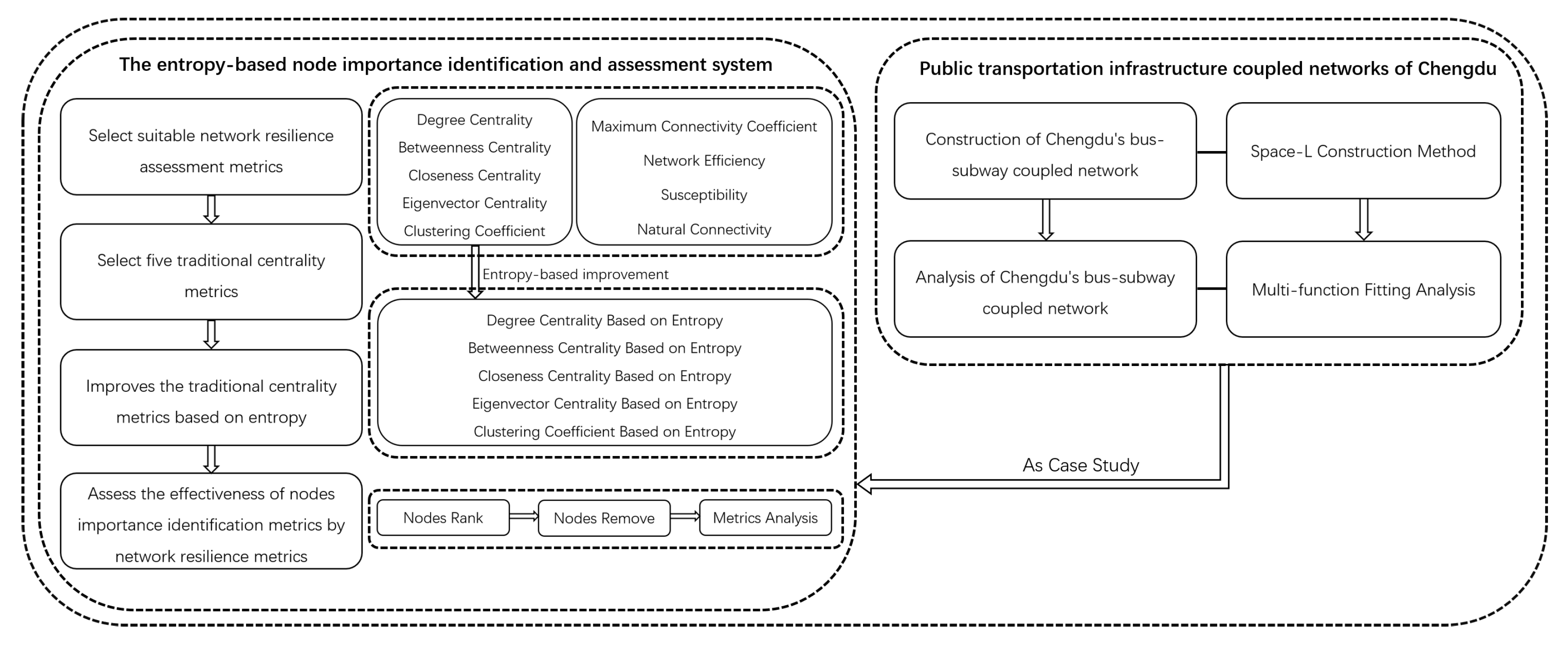

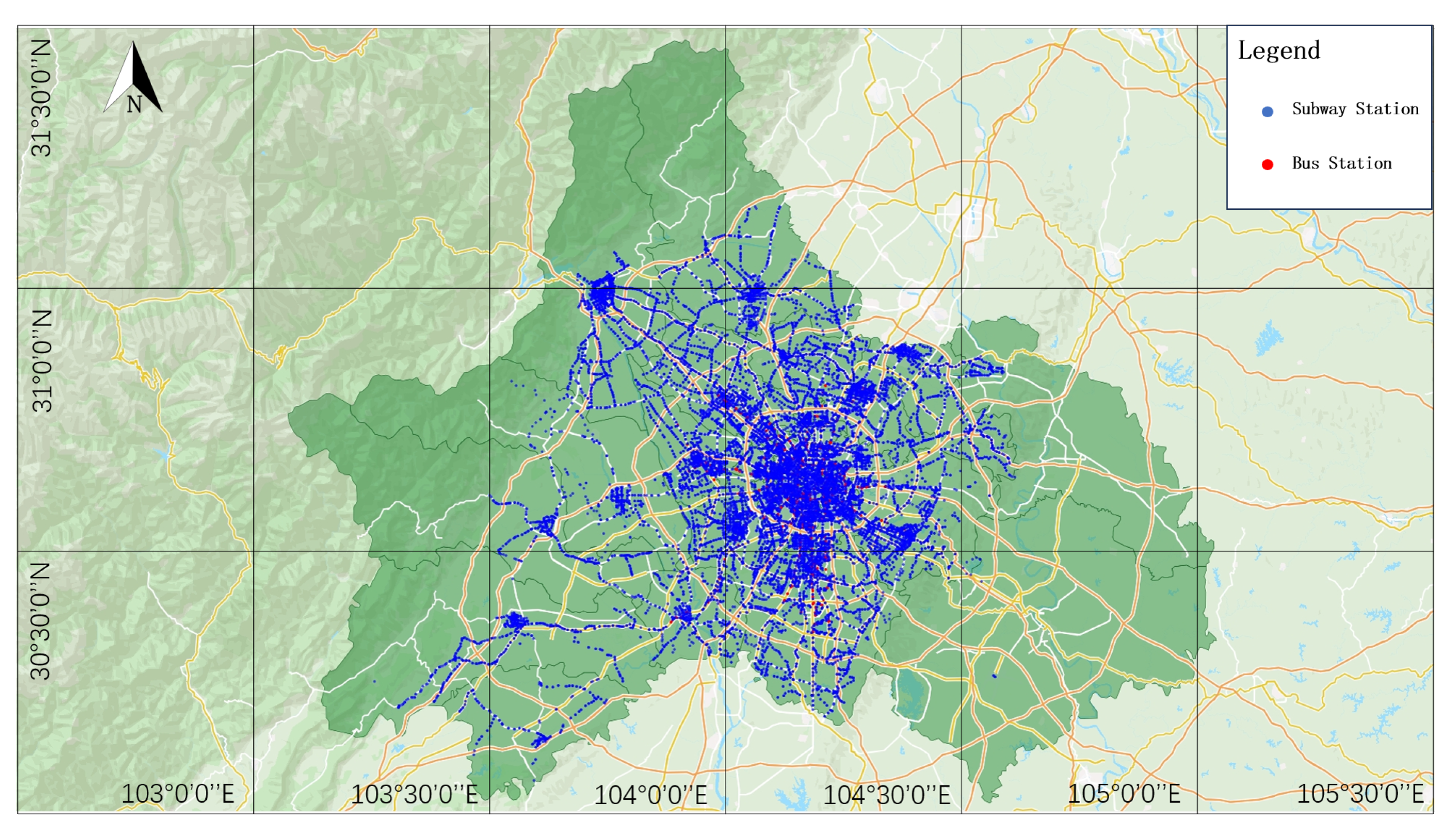
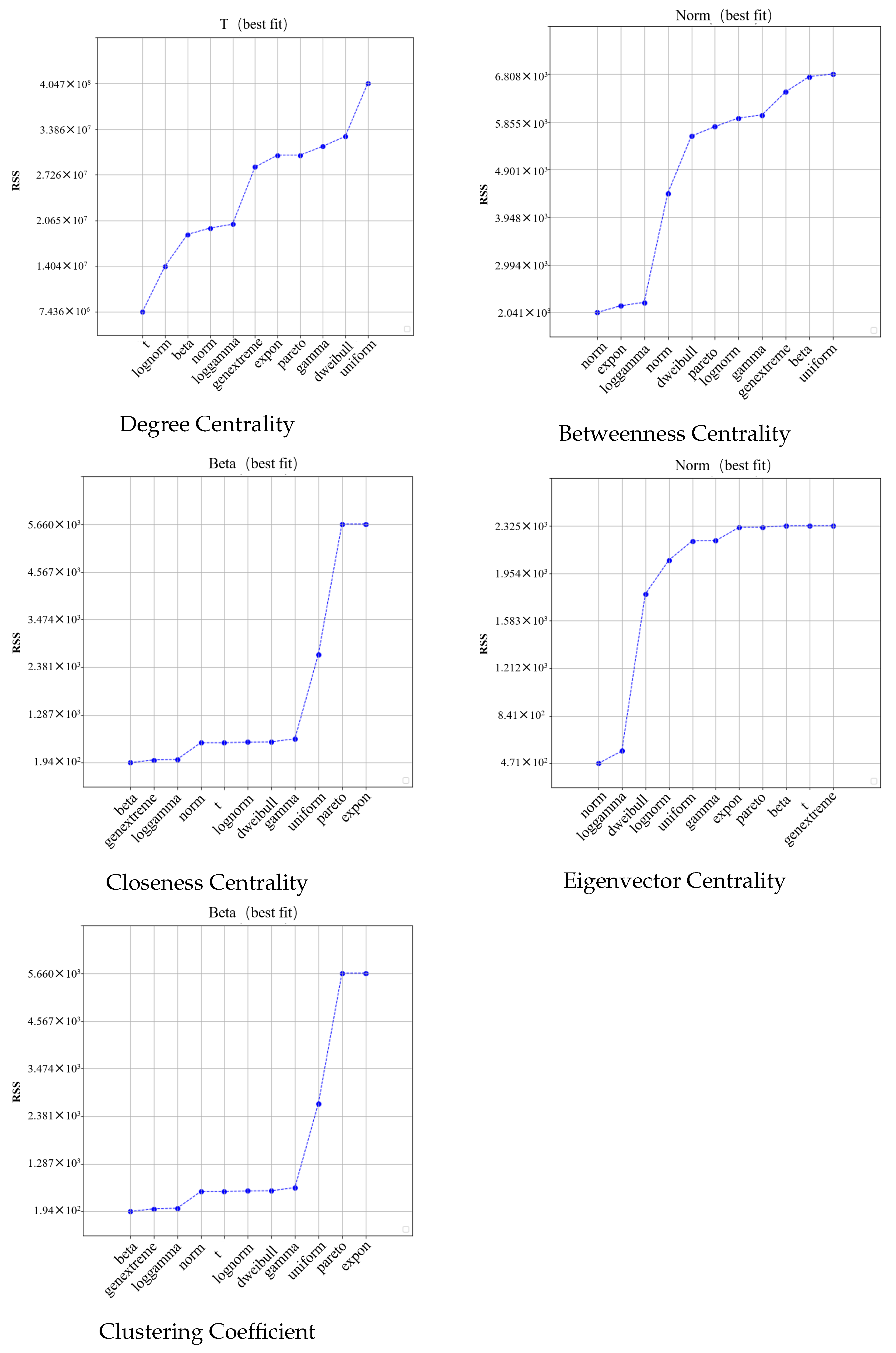

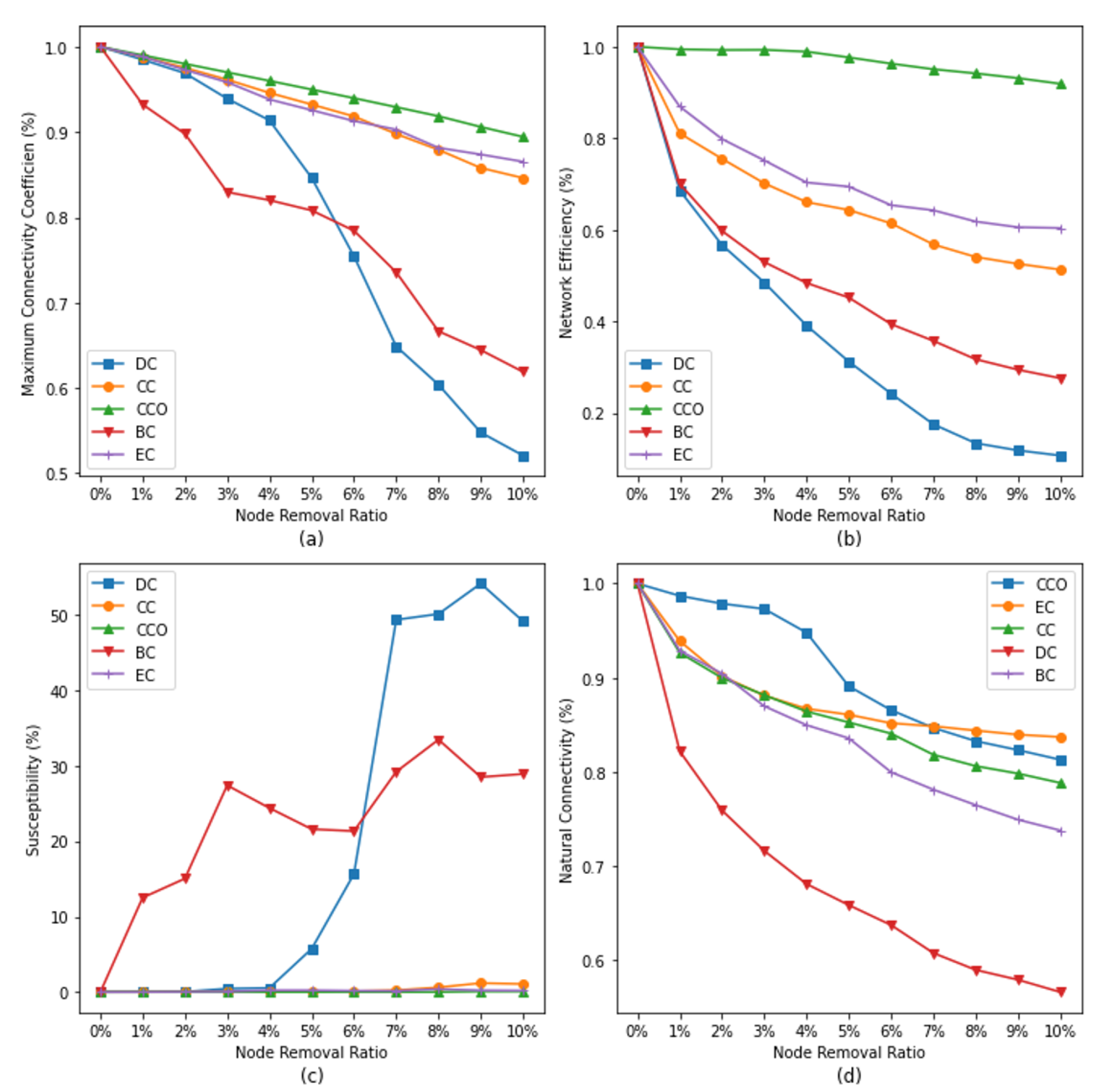

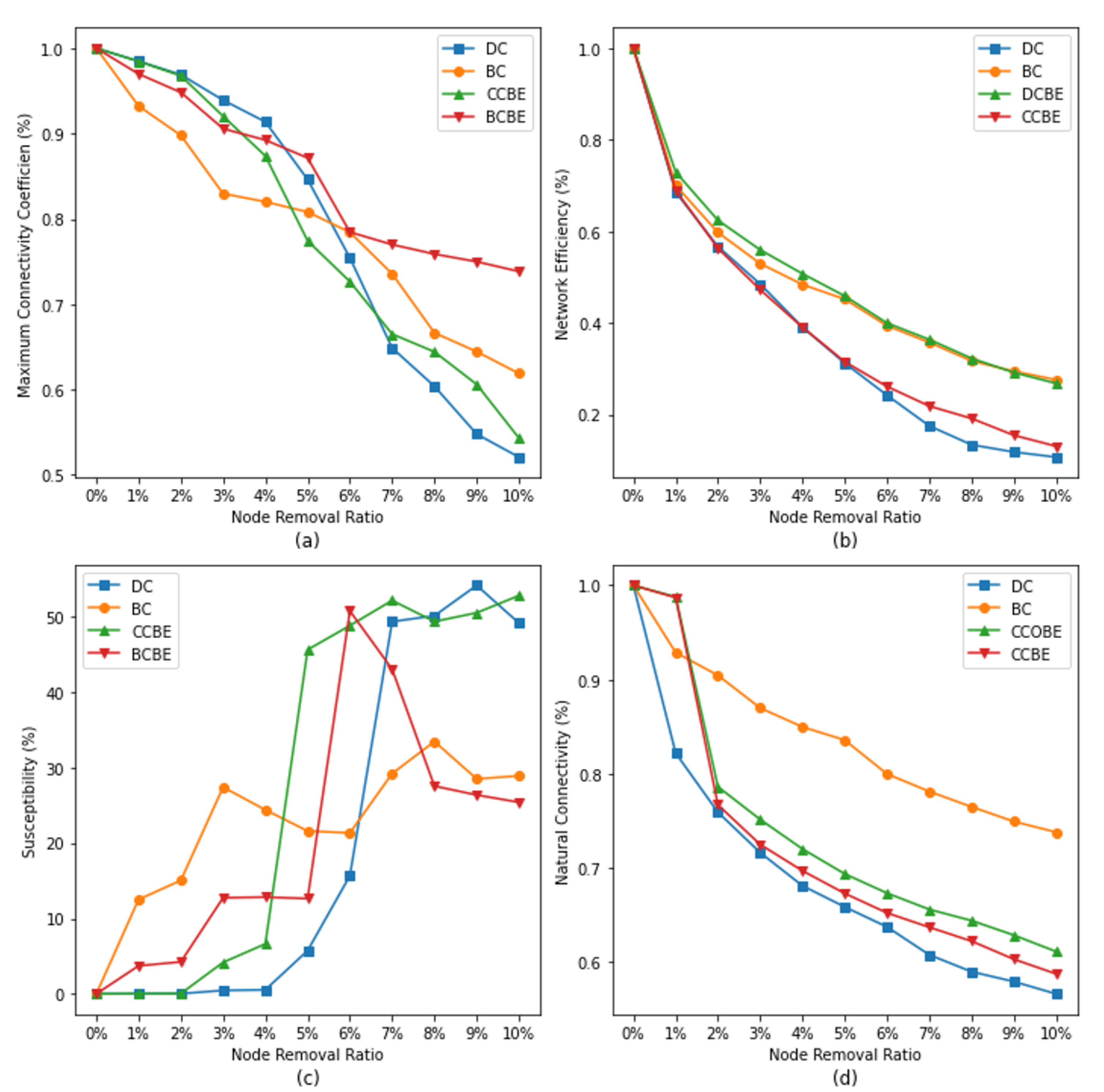
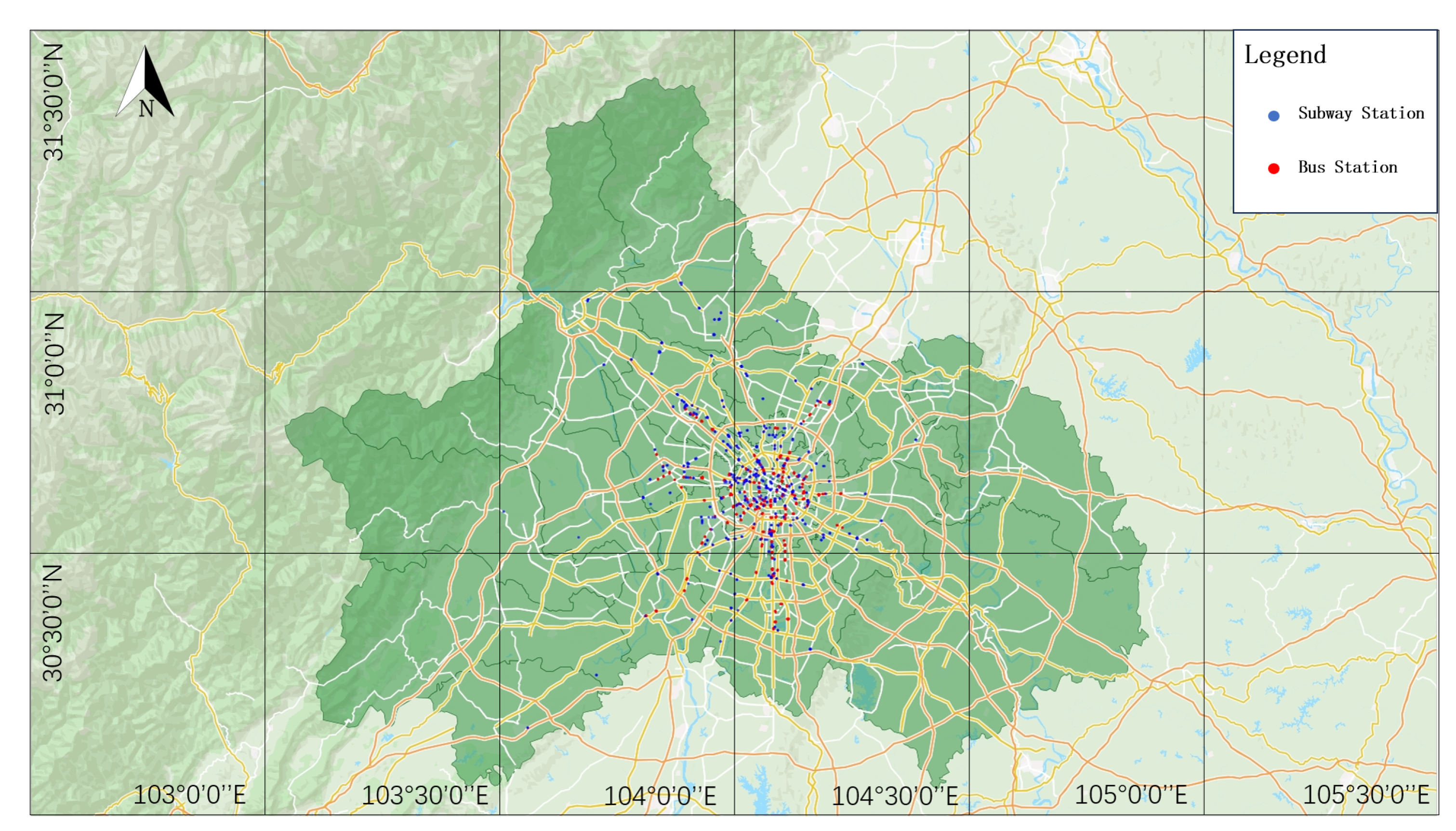
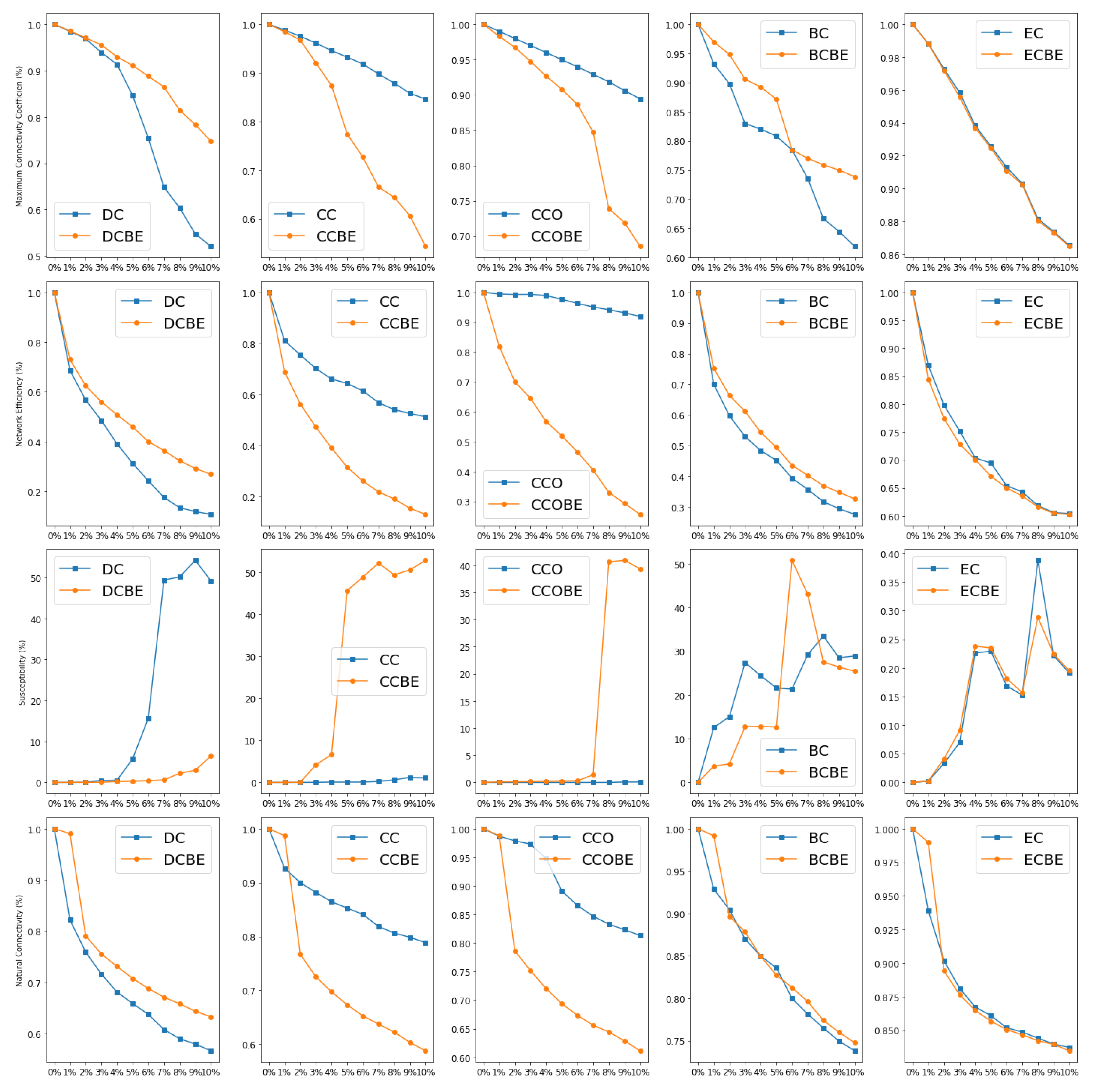
| Related Study | Node Local Information | Node Global Information | Based on Entropy | Network Type | Modeling Method |
|---|---|---|---|---|---|
| Zhong (2022) [19] | √ | √ | Single-layer | SI | |
| Yu (2022) [21] | √ | √ | √ | Single-layer | SIR and SIRS |
| Sun (2020) [22] | √ | √ | Single-layer | Attack simulation | |
| Jiang (2022) [25] | √ | Multi-layer | ASAM | ||
| Qi (2021) [27] | √ | Multi-layer | Hybrid traffic network model | ||
| Yang (2020) [15] | √ | Single-layer | Configuration model | ||
| This Study | √ | √ | √ | Multi-layer | Multifunction fitting model and attack simulation |
| Rank | DC | BC | CC | EC | CCO |
|---|---|---|---|---|---|
| 1 | 22 | 644 | 649 | 78 | 17 |
| 2 | 78 | 624 | 78 | 806 | 26 |
| 3 | 272 | 806 | 644 | 644 | 29 |
| 4 | 384 | 366 | 806 | 805 | 60 |
| 5 | 543 | 8733 | 336 | 643 | 170 |
| 6 | 729 | 643 | 643 | 1411 | 181 |
| 7 | 806 | 5127 | 1411 | 4218 | 200 |
| 8 | 336 | 3196 | 77 | 77 | 222 |
| 9 | 27 | 4507 | 10,580 | 336 | 229 |
| 10 | 226 | 543 | 478 | 649 | 257 |
| Experimental Group | Maximum Connectivity Coefficient | Network Efficiency | Susceptibility | Natural Connectivity |
|---|---|---|---|---|
| Traditional Centrality | ||||
| Metrics | ||||
| Improved Centrality | ||||
| Metrics |
Disclaimer/Publisher’s Note: The statements, opinions and data contained in all publications are solely those of the individual author(s) and contributor(s) and not of MDPI and/or the editor(s). MDPI and/or the editor(s) disclaim responsibility for any injury to people or property resulting from any ideas, methods, instructions or products referred to in the content. |
© 2024 by the authors. Licensee MDPI, Basel, Switzerland. This article is an open access article distributed under the terms and conditions of the Creative Commons Attribution (CC BY) license (https://creativecommons.org/licenses/by/4.0/).
Share and Cite
Zeng, Z.; Sun, Y.; Zhang, X. Entropy-Based Node Importance Identification Method for Public Transportation Infrastructure Coupled Networks: A Case Study of Chengdu. Entropy 2024, 26, 159. https://doi.org/10.3390/e26020159
Zeng Z, Sun Y, Zhang X. Entropy-Based Node Importance Identification Method for Public Transportation Infrastructure Coupled Networks: A Case Study of Chengdu. Entropy. 2024; 26(2):159. https://doi.org/10.3390/e26020159
Chicago/Turabian StyleZeng, Ziqiang, Yupeng Sun, and Xinru Zhang. 2024. "Entropy-Based Node Importance Identification Method for Public Transportation Infrastructure Coupled Networks: A Case Study of Chengdu" Entropy 26, no. 2: 159. https://doi.org/10.3390/e26020159
APA StyleZeng, Z., Sun, Y., & Zhang, X. (2024). Entropy-Based Node Importance Identification Method for Public Transportation Infrastructure Coupled Networks: A Case Study of Chengdu. Entropy, 26(2), 159. https://doi.org/10.3390/e26020159






